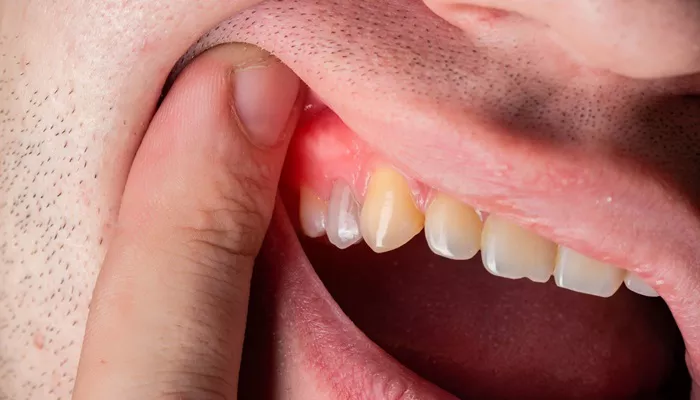gum infections causes
Main Causes of Gum Infections
1. Plaque Buildup
The most significant cause of gum infections is the formation of plaque, a sticky film of bacteria that develops on teeth when proper oral hygiene is neglected. If not removed through regular brushing and flossing, plaque can harden into tartar, which further complicates oral hygiene and leads to inflammation of the gums.
2. Poor Oral Hygiene
Inadequate brushing and flossing habits allow plaque to accumulate, leading to gingivitis. Daily oral care is crucial to prevent plaque buildup and subsequent gum disease.
3. Smoking and Tobacco Use
Smoking interferes with gum tissue health, making it more susceptible to infections. Tobacco use is a well-known risk factor for developing gum disease due to its negative impact on blood flow and healing processes in the gums.
4. Hormonal Changes
Hormonal fluctuations during pregnancy, puberty, menstruation, and menopause can increase gum sensitivity and vulnerability to infection.
These changes can make gums more reactive to plaque buildup.
5. Nutritional Deficiencies
A diet low in essential nutrients, particularly vitamin C, can weaken the immune response and impair gum health. Nutritional deficiencies can lead to increased susceptibility to infections.
6. Medical Conditions
Certain systemic diseases such as diabetes, HIV/AIDS, and cancer can compromise the immune system, making individuals more prone to gum infections. These conditions often lead to changes in oral health that facilitate bacterial growth.
7. Medications
Some medications can cause dry mouth or affect gum tissue health, increasing the risk of infection. This includes certain antihypertensives, anticonvulsants, and hormonal contraceptives.
8. Genetic Factors
A family history of gum disease may increase an individual’s risk of developing similar conditions due to inherited traits affecting immune response or oral health.
9. Dental Appliances
Poorly fitting dentures or dental appliances can create areas where plaque accumulates, leading to infections. Regular adjustments and cleanings are necessary for those with dental devices.
10. Crooked Teeth
Misaligned teeth create difficult-to-clean areas that can harbor plaque, increasing the likelihood of gum disease.
gum infections treatment
Treatment Options for Gum Infections
1. Non-Surgical Treatments
Scaling and Root Planing: This deep cleaning procedure removes plaque and tartar from below the gum line. It helps reduce inflammation and promotes healing of the gums. Improved techniques and tools have made this process more effective and comfortable for patients.
Antimicrobial Treatments: These involve the use of gels or rinses containing antibiotics or antimicrobial agents like chlorhexidine. Such treatments help control bacterial growth in the mouth and are often used after scaling to prevent recurrence of infection.
2. Topical Therapies
Recent research has introduced innovative topical treatments that target inflammation and bacterial composition in the mouth. For example, a new gel developed by researchers at NYU College of Dentistry blocks a receptor for succinate, a metabolic byproduct associated with gum disease. In studies, this gel significantly reduced inflammation and bone loss in mice models. The goal is to create an at-home application that patients can use to manage their gum health effectively.
3. Surgical Treatments
Flap Surgery: This procedure involves lifting back the gums to remove tartar deposits from deep pockets and then suturing them back in place for better healing.
Bone Grafts: In cases where bone loss has occurred, grafts can be used to regenerate lost bone tissue.
4. Regenerative Techniques
Advances in regenerative medicine offer promising treatments such as stem cell therapy and tissue engineering. These methods aim to regenerate lost gum and bone tissues using biomaterials that support healing. For instance, special membranes or proteins can encourage new tissue growth, providing a more robust solution for advanced periodontal disease.
5. Laser Therapy
Laser therapy is gaining popularity as a minimally invasive option for treating gum disease. Lasers can precisely remove infected tissue and bacteria while promoting faster healing with less discomfort compared to traditional surgical methods. This technique not only targets diseased areas but also helps preserve healthy tissue.
6. Host Modulation Therapy
This approach focuses on managing the body’s inflammatory response to periodontal pathogens. New anti-inflammatory agents are being developed to reduce destructive inflammation, thereby protecting gum tissues from damage caused by gum disease.
Best Antibiotic For Gum Infection
For treating gum infections, several antibiotics are commonly prescribed based on their effectiveness against the bacteria involved.
Here’s a summary of the best options:
Commonly Prescribed Antibiotics
Amoxicillin: This is often the first-line treatment due to its broad-spectrum activity against various bacteria. It is particularly effective for patients who are not allergic to penicillin and is usually prescribed as 500 mg taken three times a day for 3 to 7 days.
Metronidazole: Known for its effectiveness against anaerobic bacteria, which are often implicated in gum infections. It can be used alone or in combination with amoxicillin for enhanced efficacy.
Clindamycin: This antibiotic is a good alternative for patients who are allergic to penicillin. It works by inhibiting bacterial growth and is often used in more severe cases of gum disease.
Doxycycline: This antibiotic has both antibacterial and anti-inflammatory properties, making it beneficial for treating gum infections. It is effective against a broad range of bacteria.
Tetracycline: Similar to doxycycline, it helps reduce inflammation and targets specific bacteria associated with gum disease.
Azithromycin: Particularly useful for reducing bacterial growth in cases of periodontitis, especially in patients who smoke.
Ciprofloxacin: This antibiotic targets specific bacteria like A. actinomycetemcomitans, which can contribute to gum disease.

